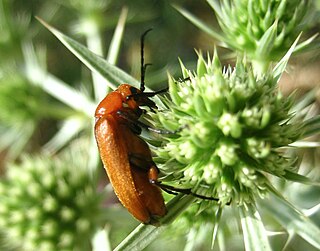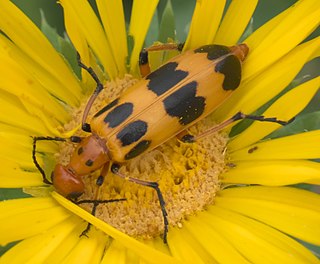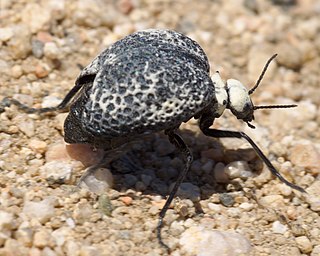
The Tenebrionoidea are a very large and diverse superfamily of beetles. It generally corresponds to the Heteromera of earlier authors.

Meloe is a genus of blister beetles commonly referred to as oil beetles. The name derives from their defensive strategy: when threatened by collectors or predators they release oily droplets of hemolymph from their joints. This fluid is bright orange and contains cantharidin, a poisonous chemical compound. Wiping the chemical on skin can cause blistering and painful swelling of the skin. This defensive strategy is not exclusive to this genus; all meloids possess and exude cantharidin upon threat.
Nemognatha chrysomeloides is a species of oil beetle (Meloidae) endemic to Central and South America.

Epicauta is a genus of beetles in the blister beetle family, Meloidae. The genus was first scientifically described in 1834 by Pierre François Marie Auguste Dejean. Epicauta is distributed nearly worldwide, with species native to all continents except Australia and Antarctica. Surveys have found the genus to be particularly diverse in northern Arizona in the United States. Few species occur in the Arctic, with none farther north than the southern Northwest Territory of Canada.

Hycleus is a genus of blister beetle belonging to the Meloidae family found in Africa and Asia. The genus contains over 400 species, which historically have been confused with the genus Mylabris.

Zonitis is a genus of blister beetles in the family Meloidae. The genus was named and described by Johan Christian Fabricius in 1775.
Lytta mutilata is a species of blister beetle in the family Meloidae. It is found in Central America and North America.
Lytta navajo is a species of blister beetle in the family Meloidae. It is found in North America.
Lytta reticulata is a species of blister beetle in the family Meloidae. It is found in North America.
Lytta melaena is a species of blister beetle in the family Meloidae. It is found in North America.

Meloinae is a subfamily of beetles in the family Meloidae. There are at least 330 described species in Meloinae.

Actenodia is a genus of blister beetles in the family Meloidae. The genus was named and described by Francis de Laporte de Castelnau in 1840.

Pyrota is a genus of blister beetles in the family Meloidae. There are at least 30 described species in Pyrota.

Lytta sayi, the Say blister beetle, is a species of blister beetle in the family Meloidae. It is found in North America.
Tetraonyx is a genus of blister beetles in the family Meloidae. There are about nine described species in Tetraonyx.
Eupompha is a genus of blister beetles in the family Meloidae. There are about 14 described species in Eupompha.

Eupomphini is a tribe of blister beetles in the family Meloidae. There are about 7 genera and more than 20 described species in Eupomphini.

Megetra is a genus of blister beetles in the family Meloidae. There are at least three described species in Megetra.
Linsleya is a genus of blister beetles in the family Meloidae. There are about five described species in Linsleya.













